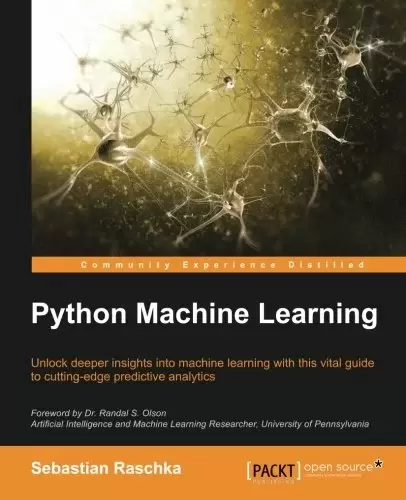
Book Description
Unlock deeper insights into Machine Leaning with this vital guide to cutting-edge predictive analytics
About This Book
- Leverage Python’s most powerful open-source libraries for deep learning, data wrangling, and data visualization
- Learn effective strategies and best practices to improve and optimize machine learning systems and algorithms
- Ask and answer tough questions of your data with robust statistical models, built for a range of datasets
Who This Book Is For
If you want to find out how to use Python to start answering critical questions of your data, pick up Python Machine Learning whether you want to get started from scratch or want to extend your data science knowledge, this is an essential and unmissable resource.
What You Will Learn
- Explore how to use different machine learning models to ask different questions of your data
- Learn how to build neural networks using Keras and Theano
- Find out how to write clean and elegant Python code that will optimize the strength of your algorithms
- Discover how to embed your machine learning model in a web application for increased accessibility
- Predict continuous target outcomes using regression analysis
- Uncover hidden patterns and structures in data with clustering
- Organize data using effective pre-processing techniques
- Get to grips with sentiment analysis to delve deeper into textual and social media data
In Detail
Machine learning and predictive analytics are transforming the way businesses and other organizations operate. Being able to understand trends and patterns in complex data is critical to success, becoming one of the key strategies for unlocking growth in a challenging contemporary marketplace. Python can help you deliver key insights into your data its unique capabilities as a language let you build sophisticated algorithms and statistical models that can reveal new perspectives and answer key questions that are vital for success.
Python Machine Learning gives you access to the world of predictive analytics and demonstrates why Python is one of the world’s leading data science languages. If you want to ask better questions of data, or need to improve and extend the capabilities of your machine learning systems, this practical data science book is invaluable. Covering a wide range of powerful Python libraries, including scikit-learn, Theano, and Keras, and featuring guidance and tips on everything from sentiment analysis to neural networks, you’ll soon be able to answer some of the most important questions facing you and your organization.
Style and approach
Python Machine Learning connects the fundamental theoretical principles behind machine learning to their practical application in a way that focuses you on asking and answering the right questions. It walks you through the key elements of Python and its powerful machine learning libraries, while demonstrating how to get to grips with a range of statistical models.
Table of Contents
Chapter 1: Giving Computers the Ability to Learn from Data
Chapter 2: Training Machine Learning Algorithms for Classification
Chapter 3: A Tour of Machine Learning Classifiers Using Scikit-learn
Chapter 4: Building Good Training Sets – Data Preprocessing
Chapter 5: Compressing Data via Dimensionality Reduction
Chapter 6: Learning Best Practices for Model Evaluation and Hyperparameter Tuning
Chapter 7: Combining Different Models for Ensemble Learning
Chapter 8: Applying Machine Learning to Sentiment Analysis
Chapter 9: Embedding a Machine Learning Model into a Web Application
Chapter 10: Predicting Continuous Target Variables with Regression Analysis
Chapter 11 : Working with Unlabeled Data – Clustering Analysis
Chapter 12: Training Artificial Neural Networks for Image Recognition
Chapter 13: Parallelizing Neural Network Training with Theano
中文:
书名:Python Machine Learning
通过这一尖端预测分析的重要指南,深入了解机器学习
About This Book
- 利用Python最强大的开源库进行深度学习、数据辩论和数据可视化
- 学习有效的策略和最佳实践,以改进和优化机器学习系统和算法
- 使用针对一系列数据集构建的强大统计模型来询问和回答有关数据的棘手问题
Who This Book Is For
如果您想了解如何使用Python开始回答您的数据的关键问题,无论您是想从头开始还是想要扩展您的数据科学知识,请选择Python机器学习,这是一个必不可少的、不容错过的资源。
What You Will Learn
- 探索如何使用不同的机器学习模型对您的数据提出不同的问题
- 了解如何使用Kera和Theano构建神经网络
- 了解如何编写干净优雅的Python代码,以优化算法的强度
- Discover how to embed your machine learning model in a web application for increased accessibility
- Predict continuous target outcomes using regression analysis
- 通过聚类发现数据中隐藏的模式和结构
- Organize data using effective pre-processing techniques
- 掌握情绪分析,更深入地研究文本和社交媒体数据
In Detail
机器学习和预测分析正在改变企业和其他组织的运营方式。能够了解复杂数据中的趋势和模式是成功的关键,成为在具有挑战性的当代市场中实现增长的关键战略之一。作为一种语言,它的独特功能允许您构建复杂的算法和统计模型,这些算法和统计模型可以揭示新的视角,并回答对成功至关重要的关键问题。
通过Python机器学习,您可以接触到预测分析的世界,并展示了为什么Python是世界领先的数据科学语言之一。如果你想问更好的数据问题,或者需要改进和扩展你的机器学习系统的能力,这本实用的数据科学书籍是无价的。它涵盖了一系列功能强大的Python库,包括SCRICIT-LEARN、Theano和Kera,并提供了从情绪分析到神经网络的各种指导和提示,您很快就可以回答您和您的组织面临的一些最重要的问题。
Style and approach
Python机器学习将机器学习背后的基本理论原理与它们的实际应用联系起来,以一种专注于提出和回答正确问题的方式。它将带您了解Python的关键元素及其强大的机器学习库,同时演示如何掌握一系列统计模型。
Table of Contents
第1章:赋予计算机从数据中学习的能力
第2章:用于分类的训练机器学习算法
第3章:使用Scikit学习机器学习分类器之旅
Chapter 4: Building Good Training Sets – Data Preprocessing
第5章:通过降维压缩数据
第6章:学习模型评估和超参数调整的最佳实践
第7章:整合不同的学习模式
第八章:机器学习在情感分析中的应用
Chapter 9: Embedding a Machine Learning Model into a Web Application
第十章:用回归分析预测连续目标变量
第11章:使用无标签数据–聚类分析
第十二章:训练用于图像识别的人工神经网络
第13章:使用Theano并行化神经网络训练
评论前必须登录!
注册